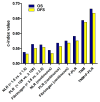Combined score based on plasma fibrinogen and platelet-lymphocyte ratio as a prognostic biomarker in esophageal squamous cell carcinoma
- PMID: 38389042
- PMCID: PMC10885567
- DOI: 10.1186/s12885-024-11968-6
Combined score based on plasma fibrinogen and platelet-lymphocyte ratio as a prognostic biomarker in esophageal squamous cell carcinoma
Abstract
Background: Increasing evidence has showed that inflammatory biomarkers, including neutrophil to lymphocyte ratio (NLR), platelet to lymphocyte ratio (PLR) and fibrinogen can be used as predictors in the prognosis of esophageal squamous cell carcinoma (ESCC). The aim of this study was to explore prognostic value of these biomarkers and evaluate the clinicopathological and prognostic significance of combined score based on plasma fibrinogen and platelet-lymphocyte ratio (F-PLR score).
Methods: A total of 506 patients with ESCC were enrolled in this study. Harrell's concordance index (c-index) was used to determine the optimal cut-off values of these markers and evaluate their prognostic significance. The relationship between factors with survival rates (including overall survival [OS] and disease-free survival [DFS]) was explored by Kaplan-Meier curve, univariate analysis and multivariate cox hazard analysis.
Results: Our result indicated that high F-PLR score was significantly associated with longer tumor length and deeper depth of tumor invasion (p < 0.01). The result of Cox multivariable analysis showed that F-PLR score was an independent prognostic factor for OS (p = 0.002) and DFS (p = 0.003). In addition, F-PLR score presented the greater c-index values for OS and DFS compared with NLR, PLR and fibrinogen level. Our result also showed that the c-index values for OS and DFS were both greater in TNM + F-PLR than those in TNM stage alone.
Conclusions: In conclusion, F-PLR score is a predictive biomarker for prognosis in patients with ESCC.
Keywords: Esophageal squamous cell carcinoma; Fibrinogen- platelet to lymphocyte ratio score; Neutrophil to lymphocyte ratio; Platelet to lymphocyte ratio; Prognosis.
© 2024. The Author(s).
Conflict of interest statement
The authors declare no competing interests.
Figures
Similar articles
-
[Study on the prognostic influencing factors of esophageal squamous cell carcinoma and the predictive value of inflammatory reaction indexes on its postoperative recurrence].Zhonghua Zhong Liu Za Zhi. 2023 Feb 23;45(2):160-164. doi: 10.3760/cma.j.cn112152-20210326-00268. Zhonghua Zhong Liu Za Zhi. 2023. PMID: 36781237 Chinese.
-
Platelet to lymphocyte ratio is a predictive marker of prognosis and therapeutic effect of postoperative chemotherapy in non-metastatic esophageal squamous cell carcinoma.Clin Chim Acta. 2018 Apr;479:160-165. doi: 10.1016/j.cca.2018.01.013. Epub 2018 Jan 8. Clin Chim Acta. 2018. PMID: 29325800
-
The pretreatment Controlling Nutritional Status (CONUT) score is an independent prognostic factor in patients with resectable thoracic esophageal squamous cell carcinoma: results from a retrospective study.BMC Cancer. 2016 Sep 6;16(1):722. doi: 10.1186/s12885-016-2696-0. BMC Cancer. 2016. PMID: 27599460 Free PMC article.
-
Prognostic value of preoperative lymphocyte-related systemic inflammatory biomarkers in upper tract urothelial carcinoma patients treated with radical nephroureterectomy: a systematic review and meta-analysis.World J Surg Oncol. 2020 Oct 23;18(1):273. doi: 10.1186/s12957-020-02048-7. World J Surg Oncol. 2020. PMID: 33097052 Free PMC article.
-
Prognostic value of platelet-to-lymphocyte ratio in patients with oral squamous cell carcinoma: a systematic review and meta-analysis.BMC Oral Health. 2024 Oct 22;24(1):1262. doi: 10.1186/s12903-024-05026-7. BMC Oral Health. 2024. PMID: 39438883 Free PMC article.
Cited by
-
Patients Undergoing Oesophageal Cancer Surgery Do Not Have Impaired Haemostasis.Clin Appl Thromb Hemost. 2025 Jan-Dec;31:10760296251327587. doi: 10.1177/10760296251327587. Epub 2025 Mar 17. Clin Appl Thromb Hemost. 2025. PMID: 40095681 Free PMC article. Clinical Trial.
References
MeSH terms
Substances
Grants and funding
LinkOut - more resources
Full Text Sources
Medical



